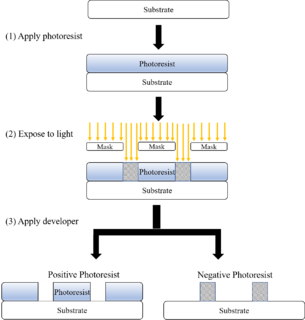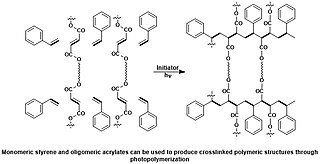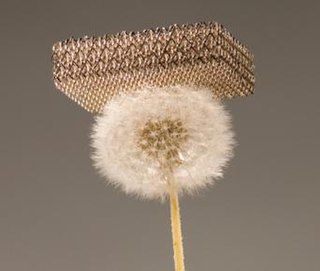
A photoresist is a light-sensitive material used in several processes, such as photolithography and photoengraving, to form a patterned coating on a surface. This process is crucial in the electronic industry.

Laser engraving, is the practice of using lasers to engrave an object. Laser marking, on the other hand, is a broader category of methods to leave marks on an object, which also includes color change due to chemical/molecular alteration, charring, foaming, melting, ablation, and more. The technique does not involve the use of inks, nor does it involve tool bits which contact the engraving surface and wear out, giving it an advantage over alternative engraving or marking technologies where inks or bit heads have to be replaced regularly.
right|250px|thumb|An SLS machine being used at the Centro Renato Archer in Brazil.]]

Stereolithography is a form of 3D printing technology used for creating models, prototypes, patterns, and production parts in a layer by layer fashion using photochemical processes by which light causes chemical monomers and oligomers to cross-link together to form polymers. Those polymers then make up the body of a three-dimensional solid. Research in the area had been conducted during the 1970s, but the term was coined by Chuck Hull in 1984 when he applied for a patent on the process, which was granted in 1986. Stereolithography can be used to create prototypes for products in development, medical models, and computer hardware, as well as in many other applications. While stereolithography is fast and can produce almost any design, it can be expensive.

3D printing, or additive manufacturing, is the construction of a three-dimensional object from a CAD model or a digital 3D model. The term "3D printing" can refer to a variety of processes in which material is deposited, joined or solidified under computer control to create a three-dimensional object, with material being added together, typically layer by layer.
Powder coating is a type of coating that is applied as a free-flowing, dry powder. Unlike conventional liquid paint which is delivered via an evaporating solvent, powder coating is typically applied electrostatically and then cured under heat or with ultraviolet light. The powder may be a thermoplastic or a thermoset polymer. It is usually used to create a hard finish that is tougher than conventional paint. Powder coating is mainly used for coating of metals, such as household appliances, aluminium extrusions, drum hardware, automobile, motorcycle, and bicycle parts. More advanced technologies allow other materials, such as plastics, composites, carbon fiber, and MDF, to be powder coated using different methods that require less heat and time.

A photopolymer or light-activated resin is a polymer that changes its properties when exposed to light, often in the ultraviolet or visible region of the electromagnetic spectrum. These changes are often manifested structurally, for example hardening of the material occurs as a result of cross-linking when exposed to light. An example is shown below depicting a mixture of monomers, oligomers, and photoinitiators that conform into a hardened polymeric material through a process called curing. A wide variety of technologically useful applications rely on photopolymers, for example some enamels and varnishes depend on photopolymer formulation for proper hardening upon exposure to light. In some instances, an enamel can cure in a fraction of a second when exposed to light, as opposed to thermally cured enamels which can require half an hour or longer. Curable materials are widely used for medical, printing, and photoresist technologies.

Rapid prototyping is a group of techniques used to quickly fabricate a scale model of a physical part or assembly using three-dimensional computer aided design (CAD) data. Construction of the part or assembly is usually done using 3D printing or "additive layer manufacturing" technology.
Chuck Hull is the co-founder, executive vice president and chief technology officer of 3D Systems. He is an inventor of the solid imaging process known as stereolithography, the first commercial rapid prototyping technology, and the STL file format. He is named on more than 60 U.S. patents as well as other patents around the world in the fields of ion optics and rapid prototyping. He was inducted into the National Inventors Hall of Fame in 2014 and in 2017 was one of the first inductees into the TCT Hall of Fame.

Objet is one of the brands of Stratasys, a maker of 3D printers. The brand began with Objet Geometries Ltd, a corporation engaged in the design, development, and manufacture of photopolymer 3D printing systems. The company, incorporated in 1998, was based in Rehovot, Israel. In 2011 it merged with Stratasys. It held patents on a number of associated printing materials that are used in PolyJet and PolyJet Matrix polymer jetting technologies. It distributed 3D printers worldwide through wholly owned subsidiaries in the United States, Europe, and Hong Kong. Objet Geometries owned more than 50 patents and patent-pending inventions.

Binder jet 3D printing, known variously as "Powder bed and inkjet" and "drop-on-powder" printing, is a rapid prototyping and additive manufacturing technology for making objects described by digital data such as a CAD file. Binder jetting is one of the seven categories of additive manufacturing processes according to ASTM and ISO.

A metallic microlattice is a synthetic porous metallic material consisting of an ultra-light metal foam. With a density as low as 0.9 mg/cm3 (0.00561 lb/ft3), it is one of the lightest structural materials known to science. It was developed by a team of scientists from California-based HRL Laboratories, in collaboration with researchers at University of California, Irvine and Caltech, and was first announced in November 2011. The prototype samples were made from a nickel-phosphorus alloy. In 2012, the microlattice prototype was declared one of 10 World-Changing Innovations by Popular Mechanics. Metallic microlattice technology has numerous potential applications in automotive and aeronautical engineering. A detailed comparative review study among other types of metallic lattice structures showed them to be beneficial for light-weighting purposes but expensive to manufacture.

UV curing is the process by which ultraviolet light is used to initiate a photochemical reaction that generates a crosslinked network of polymers. UV curing is adaptable to printing, coating, decorating, stereolithography, and in the assembly of a variety of products and materials. In comparison to other technologies, curing with UV energy may be considered a low temperature process, a high speed process, and is a solventless process, as cure occurs via direct polymerization rather than by evaporation. Originally introduced in the 1960s, this technology has streamlined and increased automation in many industries in the manufacturing sector.

EnvisionTEC is a privately held global company that develops, manufactures and sells more than 40 configurations of desktop and production 3D printers based on seven several distinct process technologies that build objects from digital design files. Founded in 2002, the company now has a corporate headquarters for North America, located in Dearborn, Mich., and International headquarters in Gladbeck, Germany. It also has a production facility in the Greater Los Angeles area, as well as additional facilities in Montreal, for materials research, in Kiev, Ukraine, for software development, and in Woburn, Mass, for robotic 3D printing research and development. Today, the company's 3D Printers are used for mass customized production and to manufacture finished goods, investment casting patterns, tooling, prototypes and more. EnvisionTEC serves a variety of medical, professional and industrial customers. EnvisionTEC has developed large customer niches in the jewelry, dental, hearing aid, medical device, biofabrication and animation industries. EnvisionTEC is one of the few 3D printer companies globally whose products are being used for real production of final end-use parts.
Projection micro-stereolithography (PµSL) adapts 3D printing technology for micro-fabrication. Digital micro display technology provides dynamic stereolithography masks that work as a virtual photomask. This technique allows for rapid photopolymerization of an entire layer with a flash of UV illumination at micro-scale resolution. The mask can control individual pixel light intensity, allowing control of material properties of the fabricated structure with desired spatial distribution.
Digital manufacturing is an integrated approach to manufacturing that is centered around a computer system. The transition to digital manufacturing has become more popular with the rise in the quantity and quality of computer systems in manufacturing plants. As more automated tools have become used in manufacturing plants it has become necessary to model, simulate, and analyze all of the machines, tooling, and input materials in order to optimize the manufacturing process. Overall, digital manufacturing can be seen sharing the same goals as computer-integrated manufacturing (CIM), flexible manufacturing, lean manufacturing, and design for manufacturability (DFM). The main difference is that digital manufacturing was evolved for use in the computerized world.
Three-dimensional (3D) microfabrication refers to manufacturing techniques that involve the layering of materials to produce a three-dimensional structure at a microscopic scale. These structures are usually on the scale of micrometers and are popular in microelectronics and microelectromechanical systems.

A variety of processes, equipment, and materials are used in the production of a three-dimensional object via additive manufacturing. 3D printing is also known as additive manufacturing, therefore the numerous available 3D printing process tend to be additive in nature with a few key differences in the technologies and the materials used in this process.
3D printing speed measures the amount of manufactured material over a given time period, where the unit of time is measured in hours, and the unit of manufactured material is typically measured in units of either kg, mm or cm3, depending on the type of additive manufacturing technique.

High-area rapid printing (HARP) is a stereolithography (SLA) method that permits the continuous, high-throughput printing of large objects at rapid speeds. This method was introduced in 2019 by the Mirkin Research Group at Northwestern University in order to address drawbacks associated with traditional SLA manufacturing processes. Since the polymerization reactions involved in SLA are highly exothermic processes, the production of objects at high-throughputs is associated with high temperatures that can result in structural defects. HARP addresses this problem by utilizing a solid-liquid slip boundary that cools the resin by withdrawing heat from the system. This allows for large structures to be fabricated quickly without the temperature-associated defects inherent to other SLA processes.













